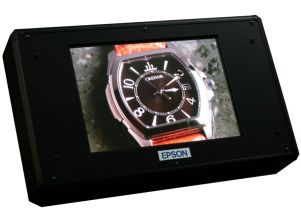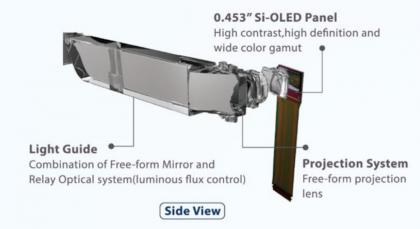 Seiko Epson is a global corporation based in Japan involved in imaging, robotics, precision machinery and electronics technologies. Seiko Epson lists on the Tokyo Stock Exchange (Ticker is JP:6724).
Seiko Epson is a global corporation based in Japan involved in imaging, robotics, precision machinery and electronics technologies. Seiko Epson lists on the Tokyo Stock Exchange (Ticker is JP:6724).
Seiko Epson started developing OLED technologies years ago. In 2004 for example the company unveiled a prototype 40-inch OLED display, and in 2009 Epson unveiled new inkjet-printing technology that will enable HDTV OLEDs. Seiko Epson aimed to produce 37" or larger TVs by 2012, but that never materialized. The company does have a small scale OLED microdisplay production line.
Today Seiko Epson is mostly focused on inkjet technologies, and has an active collaboration with Merck. In 2016 the company unveiled augmented reality glasses that use OLED microdisplays (using its own microdisplays) and since Epson released several models of these glasses and new light engines. In 2023 Seiko Epson sold 200 OLED related patents to IPValue.
3-3-5 Owa
Suwa
Nagano
Japan
IPValue buys 200 OLED patents from Seiko Epson
IPValue Management announced that it has acquired around 200 OLED patents from Seiko Epson. We do not know the nature of these patents, and whether IPValue bought all of Seiko Epson's OLED IP portfolio or just a part of it. IPValue says that the patents will be owned by its subsidiary Lumitek Display Technology.

Seiko Epson has been working on OLED technologies for many years - and it has been involved mostly with soluble OLED materials, ink-jet printing and OLED microdisplays. In 2013 Samsung Display bought several OLED patents from Seiko Epson.
UDC signed an OLED material evaluation agreement with Seiko Epson
Universal Display announced that it has signed an OLED evaluation agreement with Seiko Epson. Under the agreement, Universal Display will supply its proprietary phosphorescent OLED materials and technology to Epson for AR/VR microdisplay applications.

Seiko Epson is producing OLED microdisplays (branded as Si-OLED) for many years. It's latest announced display is a 0.453-inch 1920x1080 panel. The company's displays are used in its Moverio series of AR smartglasses. The company is also developing optical design engines (its 4th-Gen one is pictured above).
Epson announces new a OLED microdisplay and AR display engine
Seiko Epson announced that it has developed its fourth generation optical engines for smart glasses, which will be used in the company's future Moverio series - and will also be offered to customers in the consumer and industrial smart glasses markets.

The new optical engine boasts 1.5X greater density, 5X greater contrast, and a 1.5X wider field of view than Epson's previous optical engines. Epson has developed a new OLED microdisplay (branded as Si-OLED) that is 0.453-inch in size with a resolution of 1920x1080 and a contrast ratio of 500,000:1.
Epson's latest augmented reality headsets uses OLED microdisplays
Epson launched its latest augmented reality headset, the Moverio BT-300, at the Mobile World Congress last week. The main update in that version is the OLED microdisplay - which replaces the old LCD one.
The OLED is a 0.43" microdisplay-on-silicon that features a resolution of 720p, a brightness of 1,200 nits and a contrast of 100,000:1. Other features include an integrated 5mp camera and an Android 5.1 wired control-box that is based on a quad-core (1.44Ghz) Atom X5 chipset.
UBI explains their views of the OLED TV industry, gives bullish OLED market forecasts
During the OLED World Summit, an analyst from UBI gave an interesting presentation, showing the company's view of the current status of the OLED TV industry, and their OLED market forecasts for upcoming years.

So first of all, we have LG and Samsung. LGD has obviously been successful in launching WOLED OLED TVs, and scaling up to mass production has been achieved. LG is also hopeful that solution processing will enable them to produce RGB-structured OLEDs efficiently. LG is collaborating with Merck and Espon on printing technologies.
Seiko Epson developed a 360 PPI OLED ink-jet printer head, now developing a 600 PPI one
 According to OLEDNet, Seiko Epson developed a new OLED ink-jet printer head that can achieve a resolution of 360 PPI. This high-density print head uses two 180 PPI nozzles in 2 offset rows. The company managed to print prototype bottom-emitting and top-emitting OLED devices using this print head.
According to OLEDNet, Seiko Epson developed a new OLED ink-jet printer head that can achieve a resolution of 360 PPI. This high-density print head uses two 180 PPI nozzles in 2 offset rows. The company managed to print prototype bottom-emitting and top-emitting OLED devices using this print head.
OLEDNet says that Seiko Epson is now aiming to develop a 600 PPI ink-jet printer head, by using two rows of 400 PPI nozzles.
Applied Materials and Tokyo Electron merged company to be called Eteris
 In September 2013, Applied Materials and Tokyo Electron (TEL) announced that the two semiconductor manufacturing equipment makers will merge. Today the two companies announced that the new company name will be Eteris, and they also revealed the new logo. The companies expect the transaction to close in second half of 2014.
In September 2013, Applied Materials and Tokyo Electron (TEL) announced that the two semiconductor manufacturing equipment makers will merge. Today the two companies announced that the new company name will be Eteris, and they also revealed the new logo. The companies expect the transaction to close in second half of 2014.
Both Applied and TEL are engaged with OLED manufacturing equipment. Applied Materials is offering two film deposition systems suitable for LTPS or Oxide-TFT backplane deposition (for both LCD and OLEDs panels). The AKT-PX-PECVD system (shown below) is used to deposit LTPS films on large glass substrates (sized from 1.6 m2 to 5.7 m2), while the AKT-PiVoT PVD system is used to deposit metal oxide-based TFTs (IGZO in particular).
Tokyo Electron announces a new 8-gen OLED inkjet printing system
 Tokyo Electron announced that it is now accepting orders for the Elius 2500 OLED inkjet printing system. This system can produce OLEDs on 8th gen glass substrates.
Tokyo Electron announced that it is now accepting orders for the Elius 2500 OLED inkjet printing system. This system can produce OLEDs on 8th gen glass substrates.
TEL started collaborating with Seiko Epson on OLED manufacturing technology in 2010. The companies signed an agreement to jointly-develop OLED display manufacturing technology that will integrate Epson's inkjet printing method and TEL's production equipment. So after about 3.5 years, we finally see the first product that resulted from this collaboration.
UDC reports Q4 2013 results
Universal Display reported their financial results for Q4 2013. Revenues were $49.5 million (including $20 million in license fees from SDC). Total 2013 revenues were $146.6 million (up 75% from 2012). UDC ended 2013 with $273 million in cash, up from $244 in the end of 2012.

UDC also issued a guidance for 2014 - $190 to $205 million. SDC's royalty fees will be $50 million in 2014 (up from $40 in 2013). They expect most of the growth from 2013 to be in the second half of the year - due to capacity increase at SDC and LGD's Gen-8 OLED TV fab.
Semiconductor manufacturing equipment makers Applied Materials and Tokyo Electron to merge

 Applied Materials and Tokyo Electron (TEL) will merge into a new company that will have a market value of $29 billion. Applied shareholders will own approximately 68% of the new company and Tokyo Electron shareholders approximately 32%. The new company name is still unknown. Applied Materials is considered to be the world's leader in deposition and process control. According to Gartner, In 2012 Applied held 14.4% of the global semiconductor manufacturing equipment market and TEL had 11.1%.
Applied Materials and Tokyo Electron (TEL) will merge into a new company that will have a market value of $29 billion. Applied shareholders will own approximately 68% of the new company and Tokyo Electron shareholders approximately 32%. The new company name is still unknown. Applied Materials is considered to be the world's leader in deposition and process control. According to Gartner, In 2012 Applied held 14.4% of the global semiconductor manufacturing equipment market and TEL had 11.1%.
Both companies are engaged with OLED manufacturing equipment. Applied Materials is offering two film deposition systems suitable for LTPS or Oxide-TFT backplane deposition (for both LCD and OLEDs panels). The AKT-PX-PECVD system (shown below) is sed to deposit LTPS films on large glass substrates (sized from 1.6 m2 to 5.7 m2). The AKT-PiVoT PVD system is used to deposit metal oxide-based TFTs (IGZO in particular).
Pagination
- Page 1
- Next page

